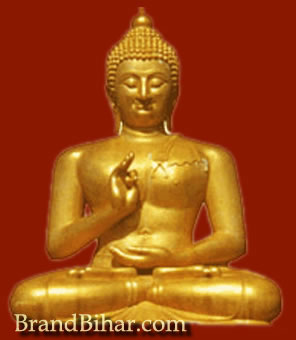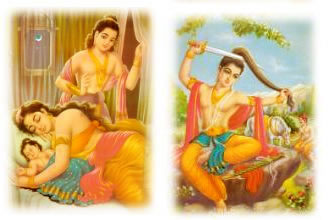Buddha's original name was Siddhartha. It meant one who had accomplished his aim. Gautama was Siddhartha's family name. Siddhartha was known all over the world as Buddha, the Enlightened. He was also known by the name of Sakhya Muni, which meant an ascetic of the Sakhya tribe.
 Siddhartha spent his boyhood at Kapilavastu and its vicinity. He was married at the age of sixteen. His wife's name was Yasodhara. Siddhartha had a son named Rahula. At the age of twenty-nine, Siddhartha Gautama suddenly abandoned his home to devote himself entirely to spiritual pursuits and Yogic practices. A mere accident turned him to the path of renunciation. One day he managed, somehow or the other, to get out of the walled enclosure of the palace and roamed about in the town along with his servant Channa to see how the people were getting on. The sight of a decrepit old man, a sick man, a corpse and a monk finally induced Siddhartha to renounce the world. He felt that he also would become a prey to old age, disease and death. Also, he noticed the serenity and the dynamic personality of the monk. "Let me go beyond the miseries of this Samsara (worldly life) by renouncing this world of miseries and sorrows. This mundane life, with all its luxuries and comforts, is absolutely worthless. I also am subject to decay and am not free from the effect of old age. Worldly happiness is transitory". Siddhartha spent his boyhood at Kapilavastu and its vicinity. He was married at the age of sixteen. His wife's name was Yasodhara. Siddhartha had a son named Rahula. At the age of twenty-nine, Siddhartha Gautama suddenly abandoned his home to devote himself entirely to spiritual pursuits and Yogic practices. A mere accident turned him to the path of renunciation. One day he managed, somehow or the other, to get out of the walled enclosure of the palace and roamed about in the town along with his servant Channa to see how the people were getting on. The sight of a decrepit old man, a sick man, a corpse and a monk finally induced Siddhartha to renounce the world. He felt that he also would become a prey to old age, disease and death. Also, he noticed the serenity and the dynamic personality of the monk. "Let me go beyond the miseries of this Samsara (worldly life) by renouncing this world of miseries and sorrows. This mundane life, with all its luxuries and comforts, is absolutely worthless. I also am subject to decay and am not free from the effect of old age. Worldly happiness is transitory".
Gautama left for ever his home, wealth, dominion, power, father, wife and the only child. He shaved his head and put on yellow robes. He marched towards Rajgriha, the capital of the kingdom of Magadha. There were many caves in the neighboring hills. Many hermits lived in those caves. Siddhartha took Alara Kalama, a hermit, as his first teacher. He was not satisfied with his instructions. He left him and sought the help of another recluse named Uddaka Ramaputta for spiritual instructions. At last he determined to undertake Yogic practices. He practiced severe Tapas (austerities) and Pranayama (practice of breath control) for six years. He determined to attain the supreme peace by practicing self-mortification. He abstained almost entirely from taking food. He did not find much progress by adopting this method. He was reduced to a skeleton. He became exceedingly weak. hermit, as his first teacher. He was not satisfied with his instructions. He left him and sought the help of another recluse named Uddaka Ramaputta for spiritual instructions. At last he determined to undertake Yogic practices. He practiced severe Tapas (austerities) and Pranayama (practice of breath control) for six years. He determined to attain the supreme peace by practicing self-mortification. He abstained almost entirely from taking food. He did not find much progress by adopting this method. He was reduced to a skeleton. He became exceedingly weak.
At that moment, some dancing girls were passing that way singing joyfully as they played on their guitar. Buddha heard their song and found real help in it. The song the girls sang had no real deep meaning for them, but for Buddha it was a message full of profound spiritual significance. It was a spiritual pick-me-up to take him out of his despair and infuse power, strength and courage. The song was:
 "Fair goes the dancing when the Sitar is tuned, "Fair goes the dancing when the Sitar is tuned,
Tune us the Sitar neither low nor high,
And we will dance away the hearts of men.
The string overstretched breaks, the music dies,
The string overslack is dumb and the music dies,
Tune us the Sitar neither low nor high."
Buddha realized then that he should not go to extremes in torturing the body by starvation and that he should adopt the golden mean or the happy medium or the middle path by avoiding extremes. Then he began to eat food in moderation. He gave up the earlier extreme practices and took to the middle path. |